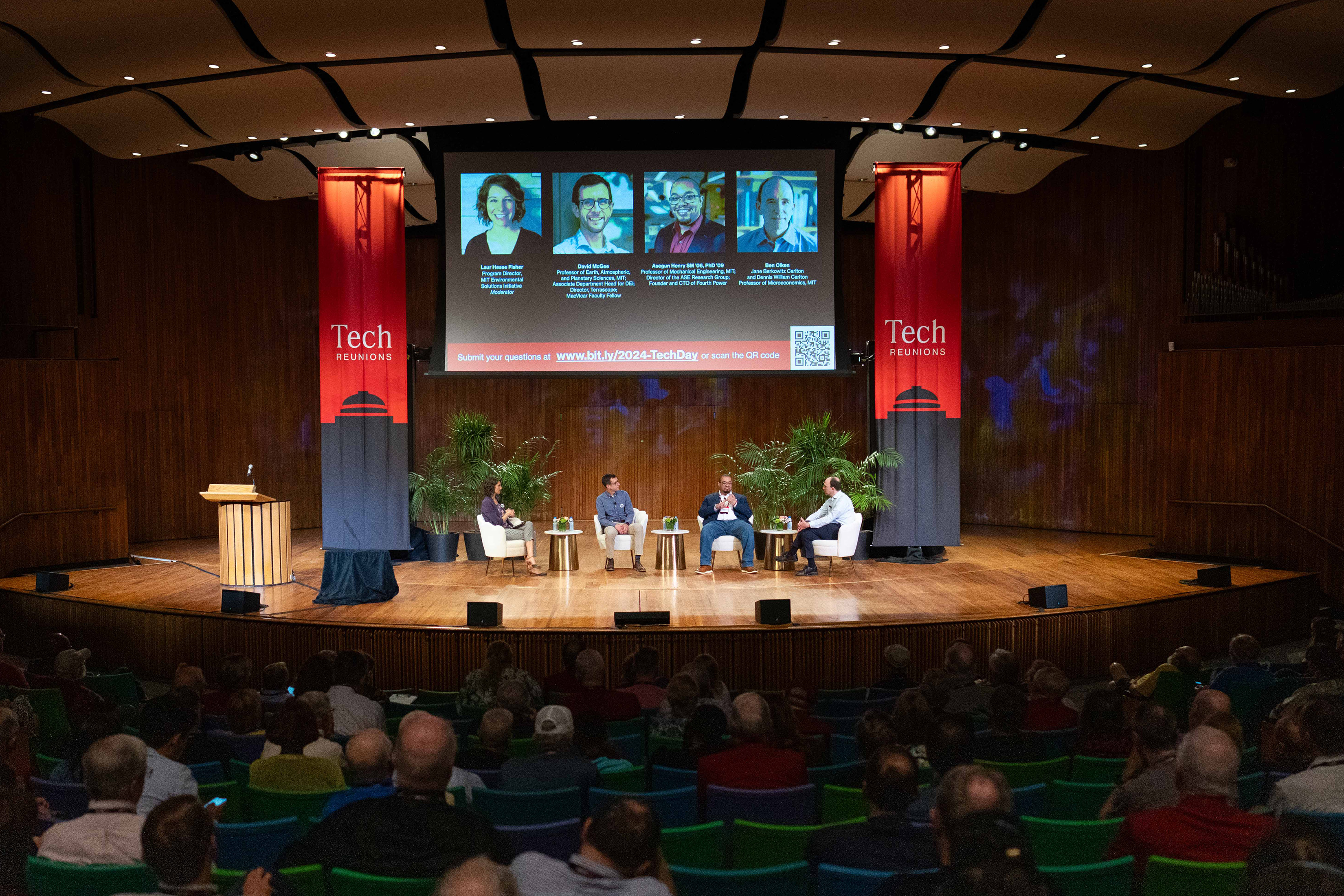Hot Topic for Tech Day: Climate
-
-
Slice of MIT
Filed Under
Recommended

Climate change innovations ranging from carbon-free cement to a “sun in a box” took center stage on June 1 as MIT held its Technology Day symposium, an annual feature of the Institute’s reunions weekend. The speakers at Organizing for Impact: MIT’s Emerging Climate Solutions highlighted the need for smart policies, particularly economic incentives, to address the world’s climate challenges.
Alumni and guests, who filled Kresge Auditorium and flocked to livestream for the event, were asked not just to listen and learn but to help. “We need our MIT network buzzing with what we know,” said Laur Hesse Fisher, program director for the MIT Environmental Solutions Initiative, who served as moderator for the day’s talks.
“Everyone has a role to play,” said Professor Desiree Plata PhD ’09. “We want you to think about what is it that you can do that overlaps with your interests to mobilize [those of us working at MIT] in this transition.”
MIT Alumni Association (MITAA) CEO Whitney Espich introduced the program, which included a fireside chat with MIT President Sally Kornbluth in addition to six talks on cutting-edge research:
- “The Economic Costs of Climate Change”
Ben Olken, the Jane Berkowitz Carlton and Dennis William Carlton Professor of Microeconomics, shared statistics on the broad impacts of high temperatures on human society—harming economic growth, industrial production, political stability, and more. “The costs of climate change are real; they’re large; they’re quantifiable,” he said, and he argued that building these costs into fuel prices could incentivize change. “Getting the price right is close to a silver bullet.” - “Powering a Renewable Future: The Pioneer Working to Put the Sun in a Box”
Professor Asegun Henry SM ’06, PhD ’09 shared how the company he founded—Fourth Power—is making renewable energy more practicable with its “sun in a box” energy storage system. The technology stores energy by heating graphite above 1,900° C, then using the light generated by the hot material to produce electricity. The system is cheaper than electrochemical storage, he said. “It’s not impossible, just extremely infeasible, but that’s what we do at MIT,” he said. - “Messages About Our Climate Future from the Deep Past”
Professor and MacVicar Faculty Fellow David McGee explained how insights drawn from his field—paleoclimatology—can inform resiliency plans. The geologic record shows the climate is a very sensitive system, he explained, with water availability “whipsawing back and forth” as temperatures climbed over a 10,000-year period. While the rate of change is now much faster, he said, understanding the past can help us develop better models for projecting the future. - “The Race for Methane Mitigation”
More damaging to the climate than CO2 and harder to eliminate from the air, methane continues to pour into the atmosphere from coal mines and agricultural activities around the world. (Coal mining alone emits 52 million metric tons of methane annually.) Plata shared how her startup, Moxair, is capturing methane. “This one technology has the opportunity to stop that atmospheric accumulation and let the Earth catch breath,” she said. - “Strategies for Developing Climate-Resilient Crops”
“Thirty percent of people around the world are moderately or severely food insecure,” Professor Mary Gehring said, noting that that number is likely to grow as climate change continues to stress agriculture. Gehring outlined efforts to make plants more climate-resilient by cloning vigorous hybrids. “This has been called the holy grail of agriculture,” she said, and she predicted such methods would be deployed within five years. - “Reinventing Industrial Materials and Processes in the Age of Decarbonization”
Portland cement is a hugely popular building material worldwide, but it is also a major contributor of greenhouse gases. “We today produce about 4 billion tons of cement a year; each ton of cement emits about a ton of CO2,” said Yet-Ming Chiang ’80, ScD ’85, MIT’s Kyocera Professor of Ceramics. “We can’t tell civilization to stop building,” he said, so his company—Sublime Systems—has another solution: an emission-free replacement cement.
Fireside Chat with President Kornbluth
Technology Day wrapped up with a fireside chat between Kornbluth and MITAA president R. Robert Wickham ’93, SM ’95, who asked the president about the new Climate Project at MIT. Kornbluth briefly outlined the scope of the project, which will take on huge missions such as decarbonizing industry, removing greenhouse gases, and developing effective policies. “This is existential. If we do not solve climate change—or we are not a big contributor to the solutions on climate change—we’re not going to have the world we need to do all the other things that we’re doing,” Kornbluth said.
To learn more, watch the Tech Day videos and explore Slice coverage of MIT Reunions 2024.
Photo: Mel Musto






